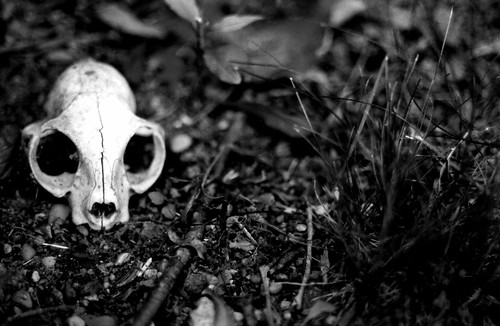

The first picture is of a domestic cat skull, photographed exactly as it was found. The second picture is November Raccoon. It is, simply, a very old raccoon skull, gnawed so much it is almost unrecognizable.
Now, there are some obvious differences between these two photographs: one is in color, the other, black and white; the compositions are quite unalike (I'll go so far as to say I like the composition in the older photograph better); the skulls are in varying positions; the skulls are of two entirely different animals. The last point is the one I want to focus on for the sake of this entry. The Useless Creatures project is a series based entirely on the photography of dead wild animals, and that choice is made for reasons I want to begin to discuss here.
To start, let's examine the first photograph, the one of the lonesome cat skull. I should mention that, as was the case with November Raccoon, there were no other bones in sight. Also like November Raccoon, the cat skull was essentially toothless and had obviously been sitting there for quite some time. Yet why -- composition and lack of color aside -- does the photograph of the cat skull stir up such different emotions in me? When I look at the first photograph, there are a few different feelings that arise.
Firstly, I have never liked the appearance of the domestic cat skull: its orbits are too large and forward-facing, its teeth (when present) look too small and sharp. I was actually quite afraid of cat skulls when I was a child -- and so this photograph gives off an eerie quality for me. It's not scary, per se, but it is creepy.
Secondly, this is a cat skull. I'll never know whether it was someone's beloved pet or a homeless, feral animal, but its life story, for me, does not change the fact that this skull belongs to a cat who is now dead. I'm a cat person -- that is, I adore cats. Before I started the Useless Creatures project, I'd see a picture of a cat skull or skeleton, and I'd become quite sad -- and I still do, to an extent, even if I never personally knew the animal. I think of the cats I've had as pets, and the ones who have died, and how we've buried them -- would I be able to stand to look at their skulls? Probably not. So for me -- and for most viewers, I might imagine -- the photograph of the cat skull does make me a little bit sad, and there's certainly this feeling of loneliness that accompanies it. (This feeling, though, is multiplied quite a bit through the composition and use of black and white. If I come across another cat skull, I'll re-shoot it in the same way I photographed November Raccoon and try this experiment again.)
Let's move on to the skull of November Raccoon. For me -- and I might imagine, for most other viewers -- this skull does not stir up feelings of sadness or eeriness. It's a raccoon skull, belonging to a wild animal that died many years ago, of who knows what. It has no significance or meaning in society, other than something that should not be looked at or touched. If it carries any connotations, it's that of revulsion. Of course, that's not my intention, and I'd like this project to eventually reverse those kinds of feelings, but that is how society tends to view the remains of dead animals -- especially "varmints" like the raccoon. After all, raccoons carry rabies. They get into your trash. They pile up on the highway shoulders, dead. Society may romanticize raccoons in children's books and rustic, woodsy art, but when presented with the real thing (or the real dead thing), many people tend to have a completely different opinion.
Again, the composition of November Raccoon is very unalike that of the cat skull. Since cat skeletons are hard to come by, perhaps I'll photograph a raccoon skull and model the composition after the photograph of the cat skull. Would different emotions arise?
Anyway, I know this entry is a bit disjointed, but I want to get these thoughts out there. What is the difference between a raccoon skull and a cat skull? Is our perception of them rooted in our upbringing, life experiences, and what society tells us to believe? Can these thoughts be reversed? Can we feel remorse for the raccoon as well? Conversely, can we be indifferent to the cat, if it's an animal we never knew?




For me, the "creepy-ness" in the first photo that is absent from the second has all to do with the eye sockets being a huge feature in the cat skull photo. Humans immediately tend to seek out the eyes in other creatures (probably not just a human trait), so I think there's a bigger emotional response to the obvious eye sockets than to the racoon skull on it's side with any resemblance of eyes facing away from the viewer. It would be interesting to compare skull views from various sides with the same skull: front, back, side. I think front view will always have a bigger impact.
ReplyDeleteI agree! Skulls with huge eye sockets freak me out - especially primate skulls. Like you suggest, I'd like to in the future do a photo-comparison of several different angles of both skulls, maybe even include some other species... deer, dog, rodent. It'd even be interesting to compare the skulls of a domestic cat and say a bobcat, or a domestic dog and a coyote -- without labeling which is which. Would peoples' reactions change upon finding out which is the domestic animal and which is the wild animal?
ReplyDelete